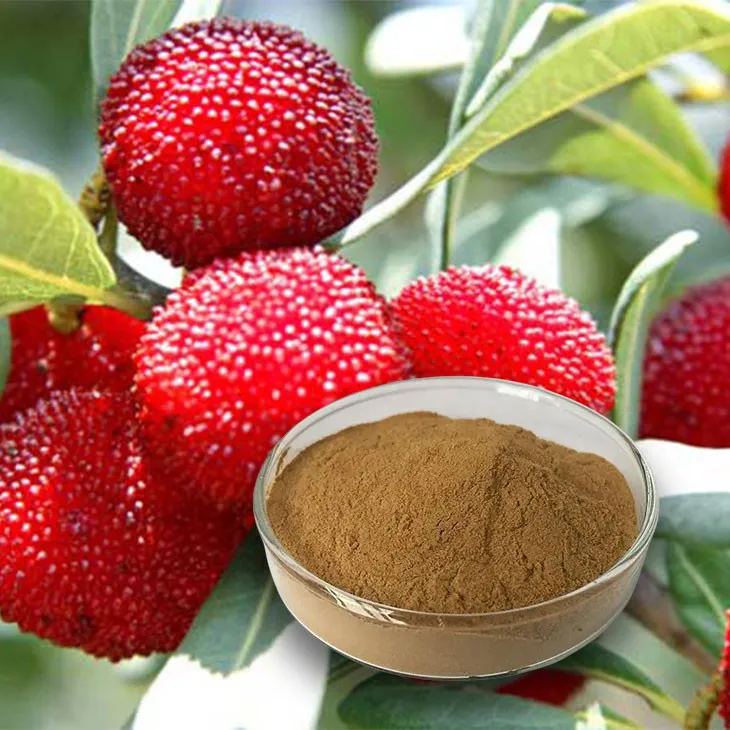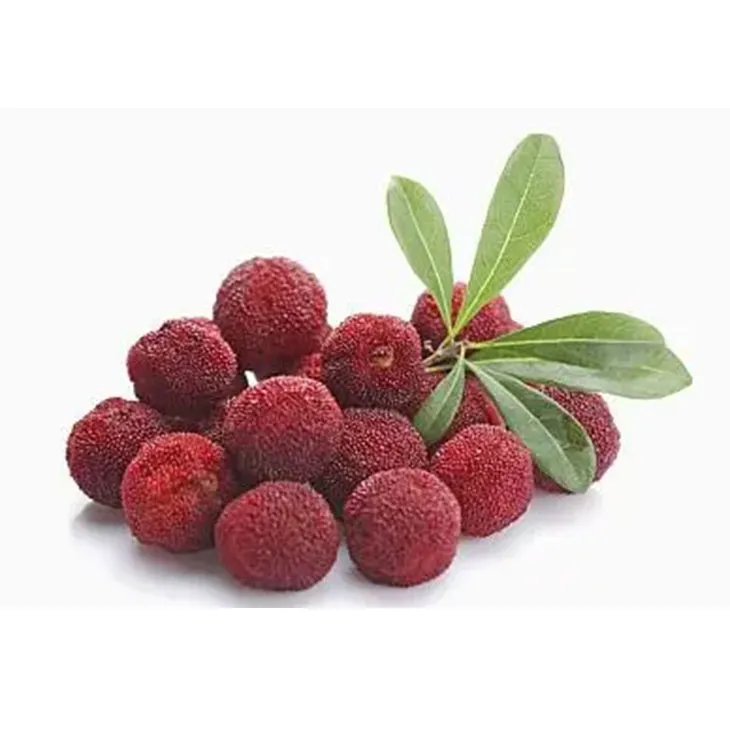- 0086-571-85302990
- sales@greenskybio.com
Active components in bayberry extracts.
2024-11-30

Introduction
Bayberry, a fruit with a long - standing history in various cultures, has been recognized not only for its delicious taste but also for its potential health benefits. The extracts obtained from bayberry are rich in a variety of active components, which have attracted significant attention in recent years. These active components are the key to understanding the many functions and applications of Bayberry Extracts in different fields such as food, cosmetics, and medicine.

Anthocyanins: The Colorful and Functional Pigments
Anthocyanins are one of the most prominent active components in Bayberry Extracts. They are responsible for the vibrant color of bayberry, which can range from deep red to purple. This color not only makes bayberry an appealing fruit but also indicates the presence of these valuable pigments.
Antioxidant Properties
One of the most important functions of anthocyanins is their antioxidant activity. In the human body, free radicals are constantly generated through normal metabolic processes as well as exposure to environmental factors such as pollution and radiation. These free radicals can cause oxidative damage to cells, including DNA damage, lipid peroxidation, and protein oxidation. Anthocyanins, with their antioxidant properties, can scavenge these free radicals, thereby protecting cells from oxidative stress. By neutralizing free radicals, anthocyanins can help reduce the risk of various chronic diseases, such as heart disease, cancer, and neurodegenerative diseases.
Anti - Aging Effects
The anti - aging effects of anthocyanins are closely related to their antioxidant activity. As we age, the accumulation of oxidative damage in the body is one of the main factors contributing to the aging process. By reducing oxidative stress, anthocyanins can help maintain the integrity of cells and tissues. They can also stimulate the production of collagen, a protein that is essential for maintaining the elasticity and firmness of the skin. This helps to reduce the appearance of wrinkles and fine lines, giving the skin a more youthful appearance. In addition, anthocyanins may also have an impact on other aspects of aging, such as improving cognitive function and protecting against age - related eye diseases.

Flavonoids: Versatile Bioactive Compounds
Flavonoids are another important class of active components in Bayberry Extracts. These compounds are widely distributed in the plant kingdom and are known for their diverse biological activities.
Antioxidant Activity
Similar to anthocyanins, flavonoids in bayberry extracts possess strong antioxidant properties. They can donate electrons to free radicals, thereby neutralizing them and preventing oxidative damage. This antioxidant activity of flavonoids is beneficial for overall health and can play a role in preventing various diseases. For example, in the cardiovascular system, flavonoids can help protect against oxidative damage to blood vessels, reduce inflammation, and improve blood lipid profiles. In the immune system, they can enhance the function of immune cells and help the body defend against infections.
Anti - microbial Activity
Flavonoids also exhibit anti - microbial activity. They can inhibit the growth of various microorganisms, including bacteria, fungi, and viruses. The mechanism of this anti - microbial action may involve interfering with the cell membranes of microorganisms, disrupting their metabolic processes, or inhibiting the replication of their genetic material. In the field of medicine, this anti - microbial activity of flavonoids can be used to develop new drugs or natural remedies for treating infectious diseases. In cosmetics, it can be used to prevent the growth of microorganisms on the skin, helping to keep the skin clean and healthy.

Other Active Components in Bayberry Extracts
In addition to anthocyanins and flavonoids, bayberry extracts also contain other active components that contribute to their overall functionality.
Tannins
Tannins are polyphenolic compounds that are present in bayberry extracts. They have astringent properties, which can be useful in certain applications. For example, in traditional medicine, tannins have been used to treat diarrhea and other gastrointestinal disorders. Tannins can also form complexes with proteins, which may have implications for the use of bayberry extracts in food processing. For instance, they can affect the texture and stability of food products.
Organic Acids
Bayberry extracts contain various organic acids, such as citric acid and malic acid. These organic acids play important roles in the flavor of bayberry and also have some physiological functions. They can contribute to the acidity of the fruit, which affects its taste. In addition, organic acids can also have a role in metabolism. For example, citric acid is involved in the Krebs cycle, an important metabolic pathway in the body. Organic acids in bayberry extracts may also have antioxidant and antimicrobial properties, although their activities may be less pronounced compared to anthocyanins and flavonoids.
Applications of Bayberry Extracts in Different Fields
Due to the presence of these active components, bayberry extracts have a wide range of applications in different fields.
Cosmetics
The antioxidant and anti - aging properties of anthocyanins and flavonoids make bayberry extracts ideal ingredients for cosmetics. They can be incorporated into skin care products such as creams, lotions, and serums to protect the skin from oxidative damage, reduce the appearance of wrinkles, and improve skin elasticity. The anti - microbial activity of flavonoids can also help keep the skin clean and free from infections. Bayberry extracts can also be used in hair care products, where they may help improve the health of the hair follicles and promote hair growth.
Medicine
In the field of medicine, the active components in bayberry extracts have potential therapeutic applications. Their antioxidant properties can be beneficial for preventing and treating chronic diseases such as heart disease, cancer, and diabetes. The anti - microbial activity of flavonoids can be used to develop new antibiotics or antiviral drugs. In addition, some traditional medicine practices have used bayberry extracts to treat various ailments, such as gastrointestinal disorders and respiratory infections. However, more research is needed to fully understand the pharmacological mechanisms and efficacy of bayberry extracts in medicine.
Food
Bayberry extracts can also be used in the food industry. Their antioxidant and antimicrobial properties can help preserve food products and extend their shelf life. They can be added to beverages, such as juices and teas, to enhance their flavor and nutritional value. In addition, the organic acids in bayberry extracts can contribute to the acidity and taste of food products, making them more appealing to consumers.
Conclusion
Bayberry extracts are rich in a variety of active components, including anthocyanins, flavonoids, tannins, and organic acids. These active components endow bayberry extracts with antioxidant, anti - aging, anti - microbial, and other functions, which make them valuable in the fields of cosmetics, medicine, and food. However, further research is still needed to fully explore the potential of these active components and to develop more effective products based on bayberry extracts. With the increasing demand for natural and functional products, bayberry extracts are likely to receive more attention in the future and play an even more important role in various industries.
FAQ:
Q1: What are the main active components in bayberry extracts?
The main active components in bayberry extracts are anthocyanins and flavonoids. Anthocyanins give the bayberry its color and possess antioxidant and anti - aging properties. Flavonoids are important for antioxidant and anti - microbial activities.
Q2: How do anthocyanins in bayberry extracts contribute to anti - aging?
Anthocyanins in bayberry extracts contribute to anti - aging through their antioxidant function. They can scavenge free radicals in the body, which are often associated with aging processes. By reducing oxidative stress, they help maintain the health and function of cells, thereby having an anti - aging effect.
Q3: Why are flavonoids in bayberry extracts valuable in the field of cosmetics?
Flavonoids in bayberry extracts are valuable in the field of cosmetics because of their antioxidant and anti - microbial activities. Antioxidant properties help protect the skin from oxidative damage caused by environmental factors such as UV radiation and pollution. Anti - microbial activities can prevent the growth of bacteria on the skin, which is beneficial for maintaining healthy skin.
Q4: Can bayberry extracts be used in medicine?
Yes, bayberry extracts can be used in medicine. The flavonoids with antioxidant and anti - microbial activities can be potentially used for various medical applications. For example, their antioxidant property may help in preventing or treating diseases related to oxidative stress, and their anti - microbial function may be useful in fighting against certain infections.
Q5: How are the antioxidant activities of anthocyanins and flavonoids in bayberry extracts measured?
There are several methods to measure the antioxidant activities of anthocyanins and flavonoids in bayberry extracts. One common method is the DPPH (2,2 - diphenyl - 1 - picrylhydrazyl) free radical scavenging assay. In this assay, the ability of the extract to scavenge DPPH radicals is measured. Another method is the ABTS (2,2'-azinobis-(3 - ethylbenzothiazoline - 6 - sulfonic acid)) assay. These assays provide quantitative data on the antioxidant capacity of the active components in bayberry extracts.
Related literature
- Analysis of Active Components in Bayberry Extracts and Their Biological Activities"
- "The Role of Bayberry Extracts' Active Components in Health and Disease"
- "Anthocyanins and Flavonoids from Bayberry: Extraction, Characterization and Bioactivities"
- ▶ Hesperidin
- ▶ citrus bioflavonoids
- ▶ plant extract
- ▶ lycopene
- ▶ Diosmin
- ▶ Grape seed extract
- ▶ Sea buckthorn Juice Powder
- ▶ Beetroot powder
- ▶ Hops Extract
- ▶ Artichoke Extract
- ▶ Reishi mushroom extract
- ▶ Astaxanthin
- ▶ Green Tea Extract
- ▶ Curcumin Extract
- ▶ Horse Chestnut Extract
- ▶ Other Problems
- ▶ Boswellia Serrata Extract
- ▶ Resveratrol Extract
- ▶ Marigold Extract
- ▶ Grape Leaf Extract
- ▶ blog3
- ▶ blog4
-
The best baicalin in nature.
2024-11-30
-
Chinese lily extract manufacturers.
2024-11-30
-
Nature's best β - carotene.
2024-11-30
-
Standard - process Coenzyme Q10.
2024-11-30
-
Bulk purchase of pomegranate extract.
2024-11-30
-
Extraction process of bilberry extract.
2024-11-30
-
Reishi mushroom extract
2024-11-30
-
Chasteberry Extract
2024-11-30
-
Tongkat Ali Extract Powder
2024-11-30
-
Tongkat Ali Extract
2024-11-30
-
Yellow Pine Extract
2024-11-30
-
Stevia Extract
2024-11-30
-
Longan Extract
2024-11-30
-
Fig Extract
2024-11-30
-
Troxerutin
2024-11-30
-
Nutmeg Extract
2024-11-30





















